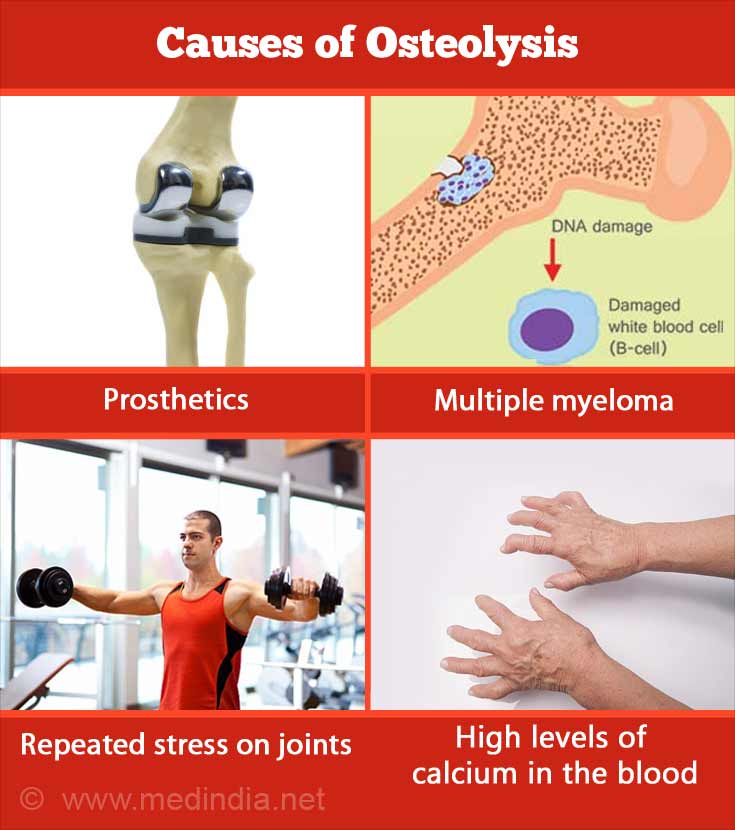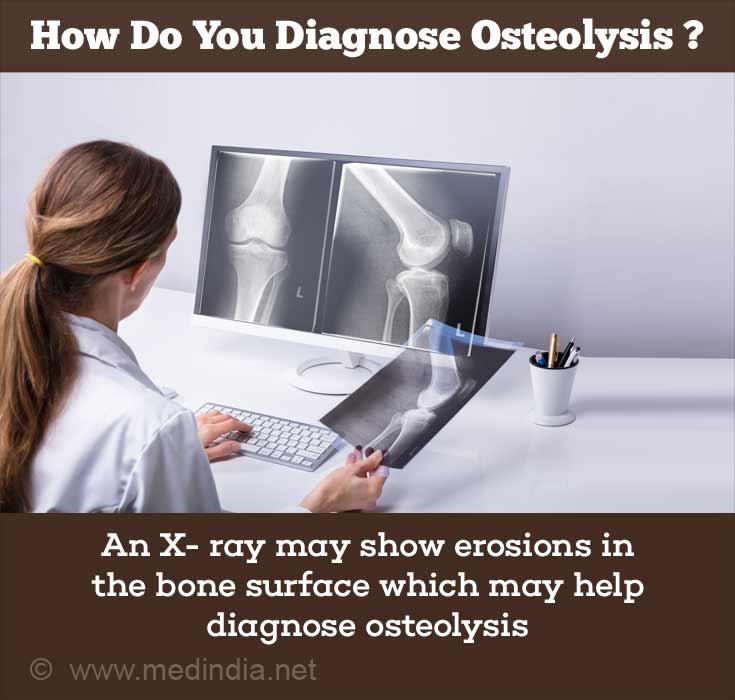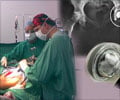- Femoral osteolysis following total hip replacement by R Dattani - (https://www.ncbi.nlm.nih.gov/pmc/articles/pmc2600070/)
- Inflammatory osteolysis: a conspiracy against bone Gabriel Mbalaviele, Deborah V. Novack, Georg Schett,and Steven L. Teitelbaum - (https://dm5migu4zj3pb.cloudfront.net/manuscripts/93000/93356/jci93356.v1.pdf)
- Allina Health- Osteolysis - (https://www.allinahealth.org/mdex/nd7658g.htm)
- Prevention of Wear Particle-Induced Osteolysis by a Novel V-ATPase Inhibitor Saliphenylhalamide through Inhibition of Osteoclast Bone Resorption by An Qin ,Tak S. Cheng, Zhen Lin, Lei Cao, Shek M. Chim, Nathan J. Pavlos, Jiake Xu, Ming Hao Zheng, Ke Rong Dai - (http://journals.plos.org/plosone/article?id=10.1371/journal.pone.0034132)
- Bone Health and Osteoporosis: A Report of the Surgeon General. - (https://www.ncbi.nlm.nih.gov/books/nbk45506/)
- Sports Participation Following Total Hip Arthroplasty by Erik P. Meira, PT, DPT, SCS, CSCS1 and Joseph Zeni,, Jr., PT, PhD - (https://www.ncbi.nlm.nih.gov/pmc/articles/pmc4223292/)
- A Water Rehabilitation Program In Patients With Hip Osteoarthritis Before And After Total Hip Replacement by Marek �yp, Ryszard Kaczor, Anna Cabak, Piotr Tederko, Ewa W�ostowska, Iwona Stanis�awska, Jan Szypu�a and Wies�aw Tomaszewski - (https://www.ncbi.nlm.nih.gov/pmc/articles/pmc4970440/)
What is Osteolysis?
Osteolysis is the wearing down or dissolution of bones. Bone is a dynamic tissue and is being continuously remodelled, by alternating bone resorption and new bone formation. Osteolysis or bone loss occurs when the body is not producing enough new bone cells to replace old bone cells. Your bones lose calcium and become thin and weak. Osteolysis refers to a pathological process where there is an active resorption of both the hard, mineral component of bone, as well as the flexible soft tissue component of bone by bone cells known as osteoclasts. Osteoclasts are cells that break down and absorb bone tissue back into the body. This condition mostly arises after joint replacement procedures.
Osteolysis is derived from “osteo” meaning bone and “lysis” meaning destruction or dissolution. This process is the opposite of ossification.Distal clavicular osteolysis (DCO) is often found in weight lifters due to high stresses put on the shoulder joint and is the most common cause of pain on the top of the shoulder in weight lifters. Also femoral osteolysis is a common occurrence after hip replacement surgery.
What are the Causes of Osteolysis?
- Prosthetics used in joint replacement surgery - The materials used for joint replacement such as cobalt and chromium may cause your body to attack bone cells. Also little particles (particulates) are generated where the prosthesis has been put in your body. These particulates activate your own immune system and result in an inflammatory process that can result in bone loss.
- Multiple myeloma (MM) - Osteolysis is the hallmark of multiple myeloma, a plasma cell malignancy which is characterized by its high capacity to induce bone destruction.
- High impact activity after joint replacement surgery
- Repeated stress on joints such as shoulder, knee and hip joints in weight lifters
- Abnormal bone growths in the form of cysts or tumors
- Arthritis
- Infections
- Periodontal disease
- Chronic inflammation of the bones or joints

What are the Symptoms & Signs of Osteolysis?
Osteolysis is a silent disease in most cases. Osteolysis itself does not produce any symptoms and signs and you may be unaware of the condition until there is sufficient damage done to the prosthesis or tissue around your bones. The damage causes loosening of the prosthesis which results in pain with any movement involving the implant and also reduced motion of the joint. There may also be abnormal bone growth.
What are the Consequences of Osteolysis?
- Fractures: The bones become thin and weak and lead to easy fractures such as a periprosthetic fracture.
- Debility: There is an accelerated and irreversible debility.
- Hospitalization: In cases where osteolysis is extreme you may require a repeat surgery and consequent hospitalization.
- Rehabilitation: This is mostly required in cases of multicentric osteolysis and osteolysis due to sports injuries.
- Dislocation.
- Aseptic loosening and polyethylene or metal wear and tear of the materials used for the implant.
How do you Diagnose Osteolysis?
The doctor will take a detailed history about your symptoms, injuries or surgeries in the past. Since osteolysis is a silent disease, the doctor will recommend following imaging tests to confirm the diagnosis.
- X rays: These 2-D images may show erosions in the bone surface or fractures. More than one x-ray may be taken.
- CT (Computerized Tomography): An x-ray machine takes 3-D pictures of your bones which may show if your bones are thin or if you have a tumor. You may be given contrast dye before the pictures are taken.
- MRI (Magnetic Resonance Imaging): This specialized test takes detailed pictures of your bones, ligaments and tendons surrounding the implant to get a better idea as to what is causing the osteolysis and breakdown of the implant.
- PET (Positron Emission Tomography): This test will clearly show bone breakdown or spread of cancer..
- Bone biopsy: This test will help to differentiate whether your osteolysis is caused by cancer cells or is due to other causes.

How can you Treat Osteolysis?
The treatment for osteolysis depends on the causative factor.
- If osteolysis is caused due to an infection then medications may be prescribed to treat the infection. Non-steroidal anti-inflammatory drugs (NSAIDs) may be prescribed to reduce the pain and inflammation.
- In cases of fracture or degenerative changes if medications do not provide any relief to the patient and the discomfort increases then surgery may be required to fix the fracture.
- In cases where arthroplasty has been done a repeat surgery may be carried out to replace the implant partially or wholly. Failure to do so can lead to loosening of the prosthesis and periprosthetic fracture which will require a complex revision surgery.
How to Prevent Osteolysis?
- It is important to regularly check up with your doctor if you have had surgery to replace a damaged joint. Your doctor may do X-rays and other imaging studies to look at condition of the implant and bone structure surrounding it to check for osteolysis. This will be helpful in knowing whether your osteolysis is getting worse or not.
- Take medicines regularly as instructed by your doctor.
- Water exercises have shown to significantly reduce pain and the use of analgesics in patients with degenerative lesions and after total hip replacement surgery.
- Land exercises such as brisk walking, stretching exercises and yoga postures done under supervision are helpful in preventing osteolysis. High impact exercises or contact sports are best avoided as they increase your risk for broken bones.







